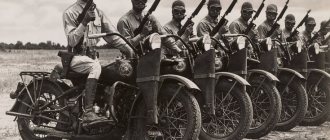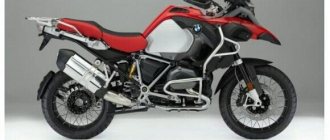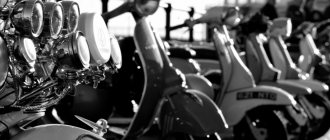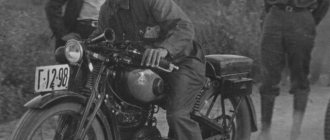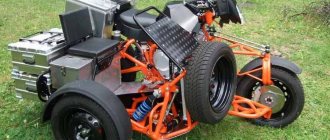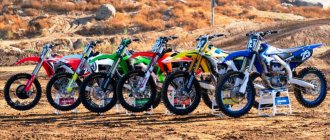If we are honest and objective, then perhaps the most correct conclusion will be that the history of the domestic motorcycle industry really begins with the Second World War. While neighboring countries were testing developments in the production of motorcycles, our country was solving its internal problems, which, against the backdrop of the First World War and the change of government and political system, did not find a place for a motorcycle project. Although later, when reading Soviet textbooks on motorcycle construction, you find interesting references created by censorship, you will not see anywhere that the most famous motorcycle was constructed from the developments of the enemy and the allies. Soviet textbooks prefer to remain silent about prototypes of their own developments.
M-72
The legendary, most famous and recognizable motorcycle among Soviet equipment. Our troops desperately needed a motorized unit capable of balancing the German BMWs and Zundapps. Yes, later the allies shared motorcycles, which were immediately dispersed along the front, but it was the M-72 that became their family and beloved workaholic.
By and large, this is a copy of the BMW R71. Here you can see the magic of numbers and many small parallels that can be read between the lines. German motorcycles are marked “R” and “K”, since the common name for “power wheel” in German is “KraftRad”. In our markings, from the German R71, we got M-72, where “M” is the designation for “Moscow”.
The Americans also looked at the successful BMW project and combined the Harlley-Davidson base with the R71 engine and cardan, and later released a full-fledged model under the symbol WLA42, which they gave us as help in 1943.
So it turns out that both prototypes M-72 and WLA42 fought against their original source BMW R71 on a common front.
Our M-72 entered the front line in 1941 with. A low center of gravity, which adds maximum stability when driving “solo”, a low-valve structure with power for each boiler (cylinder) from its own carburetor, a sidecar drive and a front fork with hydraulic shock absorption - what is not a worthy answer to Nazi Germany?
There are legends about these motorcycles and their subsequent developments, starting from the successful center of gravity, which is located almost in the fifth dimension (with such a load with which the M-72 is driven, it is incomprehensible to the mind how it does not roll over and overcome off-road conditions) to amazing survivability, and most importantly amazing performance/repairability. There are so many jokes about repairing an engine out of nothing, literally from improvised means. Maneuverability and level of cross-country ability undoubtedly do credit to this motorcycle. Yes, it is not very fast, it reaches no more than 90 km/h, but it swallows potholes with enviable success.
Subsequent developments, even in the post-war period, went to civilian use with the expectation of a possible return to the front.
The second round of development of the motorcycle industry in the USSR began during the Cold War.
This is not a joke, the Cold War really spurred us to use as much experience as possible in motorcycle design. Motorcycles during the war and after the victory became a huge help to the population in rebuilding the country. New models came out into the world so that, if necessary, the owner of a motorcycle could quickly turn from a collective farmer into a combat unit.
The only real disadvantage of this motorcycle is its weight - 380 kg, which is a lot. If the motorcycle’s breakdown is complex or it’s simply stuck off-road, it’s almost impossible to get it out alone.
Motorcycles of World War II
Motorcycles of World War II
October 25 '16
Almost all vehicles invented by man immediately after their appearance attracted close attention from the military. This statement is quite true for motorcycles. In 1885, the first motorcycles with internal combustion engines appeared in Germany, and already in 1898, British engineer Frederick Simms built a Motor Scout armed with a Maxim machine gun. This machine had a bicycle frame, saddle and handlebars. Despite its four wheels (also bicycle wheels), it looked much more like a motorcycle than a car.
During the First World War and after its end, motorcycles confidently established themselves in the armed forces of different countries. They were readily used by intelligence officers, signalmen, doctors and supplies. Motorcycles were of particular importance for the armed forces of interwar Germany, since they turned out to be one of the few types of military equipment that did not fall under the restrictions imposed on the country by the Treaty of Versailles. And by the beginning of the next world war, the armed forces of all its key participants acquired motorcycles - the most accessible means of motorization.
This review presents photographs of twenty motorcycles that were in service with the armies that fought in World War II.
If the background of the photos interferes with reading the background information for the photos, you can hover your mouse cursor over the text - this will darken the caption background
Sokoł 1000, Poland. In the photo - with a sidecar and an anti-aircraft version of the 7.9 mm Ckm wz machine gun. 30. In production since 1934. Engine capacity 995 cm³, power 18 hp. Weight (without stroller) 230 kg, maximum speed – 100 km/h
Norton WD16H, UK. In production since 1935. Engine 490 cm³, power 16.5 hp. Weight 176 kg, speed up to 110 km/h
TIZ AM-600, USSR. In production since 1935. Engine 595 cm³, power 14 hp. Weight 185 kg, speed up to 95 km/h
BMW R12, Germany. In production since 1935. Engine capacity – 745 cm³, power – 18–20 hp. Weight 162 kg, speed up to 120 km/h
Gnome-Rhône AX II, France. In production since 1936. Engine capacity – 804 cm³, power – 18.5 hp. Weight 316 kg (with sidecar), speed up to 85 km/h
Rikuo Type 97, Japan. In production since 1937. Engine capacity 1274 cm³, power 24 hp. Weight 500 kg, speed up to 96 km/h
BSA M20, UK. In production since 1937. Engine capacity – 496 cm³, power – 13 hp.
FN M12, Belgium. In production since 1937. Engine capacity 992 cm³, power – 22 hp. Weight (without stroller) 240 kg, speed up to 100 km/h
Moto Guzzi Alce, Italy. In production since 1938. Engine capacity 498 cm³, power – 13.2 hp. Weight 178 kg, speed up to 90 km/h
Matchless G3, UK. It was in service in the G3-WO (pictured) and G3/L modifications. In production since 1939. Engine capacity 349 cm³, power – 16 hp. Weight 170 (G3-WO) and 110 (G3/L) kg, speed up to 110 km/h matchlesswd.co.uk
FN 12T-3, Belgium. A tricycle created using components and assemblies of the FN M12 motorcycle. In production since 1939. Engine capacity 992 cm³, power – 22 hp. Weight 425 kg, maximum speed 75 km/h
Norton WD Big 4, UK. In production 1939. Engine capacity 633 cm³, power – 14.5 hp. Weight with stroller – about 500 kg
Harley-Davidson WLA, USA. In production since 1940. Engine capacity 740 cm³, power 23 hp. Weight 255 kg, maximum speed 110 km/h
Zündapp KS 750, Germany. In production since 1940. Engine capacity 751 cm³, power 26 hp. Weight 420 kg (with sidecar), speed up to 92 km/h
Ariel W/NG 350, UK. In production since 1940. Engine capacity 346 cm³, power – 17 hp. Weight 169 kg
Indian 841, USA. In production since 1941. Engine capacity 737 cm³, power 25 hp. Weight 240 kg, maximum speed 113 km/h
M-72, USSR. In serial production since 1941. Engine capacity 746 cm³, power 22 hp. Weight without stroller 225 kg, with stroller – 350 kg, speed up to 110 km/h
BMW R75, Germany. In production since 1941. Engine capacity 745 cm³, power – 26 hp. Weight 420 kg (with sidecar), speed up to 92 km/h
Welbike, UK. A motorcycle for special forces, when folded it fits into a standard parachute landing container (Central Landing Establishment) of the Royal Air Force. In production since 1942. Engine capacity 98 cm³, weight 32 kg, speed up to 48 km/h
Harley-Davidson XA, USA. In production since 1942. Engine capacity 740 cm³, power 23 hp. Maximum speed 105 km/h
Other developments of the Soviet military motorcycle industry
In the shadow of the M-72 you can find earlier designs, some of which again draw from Harley-Davidson. The most successful personal project of the USSR can be considered the L-8, 350 cubic meters of engine, with an overhead valve structure. And everything would be fine, the motorcycle proved to be not bad, but it was produced at different factories, where the standards were not observed as strictly as those of the German enemy. As a result, the soldiers faced real trouble during repairs, since the model’s configurations, although they had the same structure, could not match the details in terms of dimensions and gaps. In other words, a spare part from one motorcycle may not be 100% suitable for the same motorcycle from another factory.
The same problem arose with the release of the M-72. The motorcycles were assembled at different factories in the country and did not have 100% accuracy in compliance with the drawings in the dimensions of parts down to mm.
Military developments in chronological order:
- L300
- HMZ 350
- TIZ-AM600
- Izh-8
- Izh-9
- L-8
Allied motorcycles
Allied countries provided the Soviet army with a modest number of motorcycles such as Harley-Davidson WLA45 and 741 Military Scott, even Indian. It should be noted that the most serious motorcycles were distributed to the senior ranks, while the simpler ones were adapted and often combined with our M-72 sidecars.
Conclusion: motorcycles in Soviet history during the Second World War became an integral part of the life of the population of our country, later occupying an important place in people’s lives. Motorcycles were not only a way of transportation and delivery of ammunition, but also replaced horse-drawn transport. It was the development of the wartime motorcycle industry that created the main system of motorcycle production in the USSR.
The Great Patriotic War and military motorcycles
German motorcycles of the Second World War consisted of only two models - the BMW R75 and the Zundapp KS750. They performed well off-road and produced good power. Both units had all-wheel drive; we put strollers on the wheel. But the cost of these models did not allow the use of the equipment in Germany. Therefore, all produced equipment was sent from the assembly line to foreign buildings. This continued from 1940 to 1942. Then the decision came to release a modified version of the KS750 with a trailer from BMW . True, the model was never produced in mass production, since the previous order from the state for 40,000 copies of models with a sidecar was not fully completed, stopping at the production of approximately 17,000 mopeds.
Throughout the war, the Germans produced a motorcycle with caterpillar tracks. Such an innovation was surprising not only for opponents, but also for Germany itself. The model was called Kettenkrad and was produced for five years, during which about 8.5 thousand such devices were created. Due to the installed tracks, the bike's cross-country ability in the most difficult conditions was significantly increased. True, when turning, the equipment often turned over, while the driver did not have time to jump due to the difficulties of landing. Moreover, the significant weight of the unit did not allow it to climb the slopes in a diagonal trajectory.
Like all German motorcycles of the Second World War, the Kettenkrad had a large engine with a volume of one and a half liters. True, in appearance such a device was more reminiscent of a small infantry fighting vehicle than a motorcycle. It was convenient to transport people. I was also pleased with the ease of control, albeit with minor shortcomings, but for a bike with such dimensions the idea was very good. The Wehrmacht tracked motorcycle, with all the abundance of iron cover, weighed quite a bit - only 325 kilograms. For a 1.4-liter engine that produced 26 horsepower, such a mass did not cause any particular problems.
German units made a great impression not only on Soviet manufacturers. After the war, many foreign analogues of the BMW R71 model were created. For example, Harley borrowed BMW's four-speed gearbox and driveshaft drive to the rear of the motorcycle.



